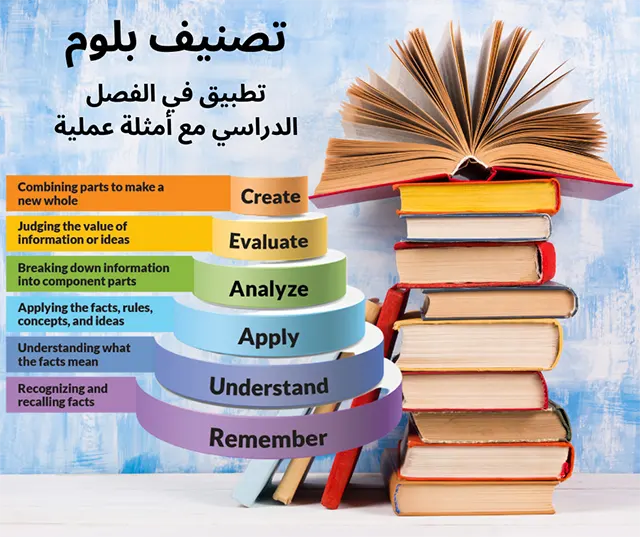
تحليل شامل لتصنيف بلوم المعدل: السياق، الشرح، وتطبيقه في الفصل الدراسي
تصنيف بلوم، الذي طوره بنيامين بلوم وزملاؤه في عام 1956، كان ولا يزال من الركائز الأساسية في النظرية والممارسة التعليمية. يوفر التصنيف إطارًا هرميًا لتصنيف الأهداف التعليمية، بهدف تعزيز التفكير الأعلى وعمليات التعلم. في عام 2001، قدم لورين أندرسون وديفيد كراتوول نسخة معدلة من تصنيف بلوم لتلبية الانتقادات ولتعكس بشكل أفضل الفهم العصري لعمليات التفكير. تقدم هذه المقالة استكشافًا مفصلاً لتصنيف بلوم المعدل، وتوضيح أهميته، وتقديم إرشادات عملية حول كيفية استخدامه في الفصل الدراسي لتعليم مواد مختلفة.
1. سياق تصنيف بلوم المعدل
1.1. الخلفية التاريخية
تم تطوير تصنيف بلوم الأصلي لتصنيف الأهداف التعليمية إلى تسلسل هرمي من المهارات المعرفية. كان التصنيف مقسمًا إلى ستة مستويات: المعرفة، الفهم، التطبيق، التحليل، التركيب، والتقييم. كل مستوى يمثل خطوة في عملية التفكير، من الاسترجاع الأساسي للحقائق إلى التقييم المعقد ودمج المعلومات.
في عام 2001، قام لورين أندرسون، أحد طلاب بلوم السابقين، وديفيد كراتوول، أحد المتعاونين الأصليين مع بلوم، بتعديل التصنيف لتلبية بعض الانتقادات وتحسين التوافق مع الممارسات التعليمية المعاصرة. هدف هذا التعديل إلى معالجة بعض قيود التصنيف الأصلي، مثل طبيعته الخطية وافتقاره إلى التركيز على الطبيعة الديناميكية والدورية للتعلم.
1.2. التعديلات الرئيسية في التصنيف المعدل
يشمل التصنيف المعدل عدة تغييرات رئيسية:
الانتقال من الأسماء إلى الأفعال: يستخدم التصنيف المعدل الأفعال لوصف العمليات المعرفية، مما يعكس رؤية أكثر ديناميكية للتعلم. على سبيل المثال، تم استبدال "التقييم" بـ "تقييم" لتأكيد الطبيعة النشطة للعمليات المعرفية المعنية.
المستويات المعدلة: تم إعادة هيكلة المستويات الأصلية لتصنيف بلوم إلى إطار عمل ثنائي الأبعاد: بعد العملية المعرفية وبعد المعرفة. يشمل بعد العملية المعرفية: التذكر، الفهم، التطبيق، التحليل، التقييم، والإبداع، بينما يشمل بعد المعرفة: المعرفة الواقعية، المفاهيمية، الإجرائية، والميتامعرفية.
2. فهم تصنيف بلوم المعدل
2.1. بعد العملية المعرفية
يوضح بعد العملية المعرفية ستة مستويات من العمليات المعرفية، من الأكثر أساسية إلى الأكثر تعقيدًا:
التذكر: يشمل استرجاع الحقائق والمفاهيم الأساسية. هذا هو المستوى الأساسي حيث يسترجع الطلاب المعلومات التي تعلموها مسبقًا.
الفهم: يشمل تفسير الأفكار أو المفاهيم. يوضح الطلاب فهمهم من خلال تفسير المعلومات وتلخيصها واستنتاجها.
التطبيق: يشمل استخدام المعلومات في مواقف جديدة. يقوم الطلاب بتطبيق المعرفة لحل المشكلات وإجراء المهام.
التحليل: يشمل تفكيك المعلومات إلى أجزاء لاستكشاف العلاقات. يقوم الطلاب بفحص وتنظيم المعلومات لتحديد الأنماط والاتصالات.
التقييم: يشمل اتخاذ الأحكام بناءً على المعايير. يقيم الطلاب قيمة أو فعالية المعلومات أو الحلول.
الإبداع: يشمل تجميع العناصر لتشكيل كل متماسك أو وظيفي. ينشئ الطلاب أفكارًا جديدة أو منتجات من خلال دمج وإعادة تنظيم المعلومات.
2.2. بعد المعرفة
يصنف بعد المعرفة أنواع المعرفة التي يمكن أن يكتسبها الطلاب:
المعرفة الواقعية: العناصر الأساسية والمصطلحات التي تعد ضرورية لفهم موضوع معين.
المعرفة المفاهيمية: العلاقات بين العناصر الأساسية وبنية المجال.
المعرفة الإجرائية: كيفية أداء المهام وحل المشكلات ضمن مجال معين.
المعرفة الميتامعرفية: الوعي وفهم العمليات والاستراتيجيات المعرفية الخاصة بالذات.
3. تطبيق تصنيف بلوم المعدل في الفصل الدراسي
3.1. تدريس مواد مختلفة
يمكن تطبيق تصنيف بلوم المعدل عبر مواد مختلفة لتعزيز التدريس والتعلم. فيما يلي كيفية استخدامه في مجالات مختلفة:
3.1.1. الرياضيات
التذكر: يتذكر الطلاب الصيغ الرياضية والتعريفات.
الفهم: يفسر الطلاب المفاهيم والمبادئ الرياضية، مثل خصائص الأشكال الهندسية.
التطبيق: يستخدم الطلاب الصيغ الرياضية لحل المشكلات أو إكمال المعادلات.
التحليل: يقوم الطلاب بتفكيك المشكلات المعقدة إلى أجزاء أبسط واستكشاف الأنماط والعلاقات.
التقييم: يقيم الطلاب فعالية استراتيجيات أو طرق حل المشكلات المختلفة.
الإبداع: يطور الطلاب نماذج رياضية جديدة أو استراتيجيات لحل المشكلات.
3.1.2. العلوم
التذكر: يتذكر الطلاب الحقائق والمصطلحات العلمية.
الفهم: يصف الطلاب العمليات أو الظواهر العلمية، مثل التمثيل الضوئي.
التطبيق: ينفذ الطلاب التجارب ويطبقون المبادئ العلمية لتحليل النتائج.
التحليل: يستكشف الطلاب البيانات العلمية ويحددون الاتجاهات أو الشذوذ.
التقييم: يقيم الطلاب صحة النظريات العلمية أو موثوقية نتائج التجارب.
الإبداع: يطور الطلاب تجاربهم الخاصة أو يطرحون فرضيات علمية جديدة.
3.1.3. الأدب
التذكر: يتذكر الطلاب نقاط الحبكة الرئيسية والشخصيات والمواضيع في عمل أدبي.
الفهم: يلخص الطلاب المواضيع أو الرسائل في نص ويقومون بتفسير دوافع الشخصيات.
التطبيق: يستخدم الطلاب النظريات الأدبية لتحليل النصوص أو تطبيق العناصر الموضوعية في سياقات جديدة.
التحليل: يستعرض الطلاب كيف تسهم العناصر الأدبية مثل الرمزية أو السخرية في المعنى العام للنص.
التقييم: ينقد الطلاب فعالية استخدام الكاتب للأدوات الأدبية أو مصداقية تطورات الحبكة.
الإبداع: يكتب الطلاب قصصًا أو قصائد خاصة بهم، مع دمج تقنيات وأسلوب أدبي.
3.1.4. الدراسات الاجتماعية
التذكر: يتذكر الطلاب التواريخ والأحداث والشخصيات التاريخية.
الفهم: يشرح الطلاب أسباب وآثار تاريخية أو يفسرون الوثائق التاريخية.
التطبيق: يستخدم الطلاب المعرفة التاريخية لفهم الأحداث الحالية أو حل دراسات حالة تاريخية.
التحليل: يستعرض الطلاب العلاقات بين الأحداث التاريخية وتأثيراتها على المجتمعات.
التقييم: يقيم الطلاب أهمية الأحداث التاريخية أو فعالية السياسات التاريخية.
الإبداع: يطور الطلاب روايات تاريخية خاصة بهم أو يقترحون حلولًا لمشاكل تاريخية.
3.2. تصميم التدريس والتقييم
لتكامل تصنيف بلوم المعدل بفعالية في التدريس والتقييم، يمكن للمعلمين:
تصميم الأهداف التعليمية: استخدم التصنيف لإنشاء أهداف تعليمية واضحة وقابلة للقياس تعكس مستويات مختلفة من العمليات المعرفية.
تطوير التقييمات: إنشاء تقييمات تتماشى مع التصنيف، وضمان أن الأسئلة أو المهام تتطلب من الطلاب إظهار مهارات معرفية متنوعة.
تخطيط الدروس: هيكل الدروس لبناء مهارات الطلاب المعرفية بشكل تدريجي، بدءًا من المعرفة الأساسية وصولاً إلى التفكير الأعلى.
تيسير التعلم النشط: تشجيع الأنشطة التي تعزز التفكير الأعلى، مثل المناقشات، المشاريع، وتمارين حل المشكلات.
يقدم تصنيف بلوم المعدل إطارًا قيمًا لفهم وتعزيز التفكير الأعلى في التعليم. من خلال تصنيف العمليات المعرفية وأنواع المعرفة، يوفر التصنيف للمعلمين نهجًا منظمًا لتصميم التدريس والتقييم والأنشطة التعليمية. يتيح تطبيق تصنيف بلوم المعدل في الفصل الدراسي نهجًا أكثر شمولًا وديناميكية للتدريس، مما يعزز قدرة الطلاب على المشاركة في التفكير النقدي وحل المشكلات عبر مواد مختلفة. مع استمرار المعلمين في تعديل وتنفيذ هذه الاستراتيجيات، يظل تصنيف بلوم المعدل أداة حيوية لتعزيز تجارب التعلم الفعالة والمفيدة.
Bloom's Taxonomy, originally developed by Benjamin Bloom and his colleagues in 1956, has long been a cornerstone in educational theory and practice. The taxonomy provides a hierarchical framework for categorizing educational goals, aimed at fostering higher-order thinking and learning. In 2001, a revised version of Bloom’s Taxonomy was introduced by Lorin Anderson and David Krathwohl to address criticisms and to better reflect contemporary understandings of cognitive processes. This essay provides a detailed exploration of Bloom's Revised Taxonomy, contextualizes its significance, and offers practical guidance on how it can be utilized in the classroom to teach various subjects.
1. Contextualizing Bloom’s Revised Taxonomy
1.1. Historical Background
Bloom's original taxonomy was developed to classify educational objectives into a hierarchy of cognitive skills. The taxonomy was divided into six levels: Knowledge, Comprehension, Application, Analysis, Synthesis, and Evaluation. Each level represented a step in the cognitive process, from basic recall of facts to complex evaluation and synthesis of information.
In 2001, Lorin Anderson, a former student of Bloom, and David Krathwohl, one of Bloom's original collaborators, revised the taxonomy to better reflect current educational practices. This revision aimed to address some limitations of the original taxonomy, such as its linear nature and lack of emphasis on the dynamic, iterative nature of learning.
1.2. Key Changes in the Revised Taxonomy
The revised taxonomy includes several key changes:
Shift from Nouns to Verbs: The revised taxonomy uses verbs to describe cognitive processes, reflecting a more dynamic view of learning. For example, "Evaluation" was replaced with "Evaluate" to emphasize the active nature of the cognitive processes involved.
Revised Levels: The original levels of Bloom's Taxonomy were restructured into a two-dimensional framework: the Cognitive Process Dimension and the Knowledge Dimension. The cognitive process dimension includes Remember, Understand, Apply, Analyze, Evaluate, and Create, while the knowledge dimension includes Factual, Conceptual, Procedural, and Metacognitive knowledge.
2. Understanding Bloom’s Revised Taxonomy
2.1. The Cognitive Process Dimension
The Cognitive Process Dimension outlines six levels of cognitive processes, from the most basic to the most complex:
Remember: Involves recalling facts and basic concepts. This is the foundational level where students retrieve previously learned information.
Understand: Involves explaining ideas or concepts. Students demonstrate comprehension by interpreting, summarizing, and inferring information.
Apply: Involves using information in new situations. Students apply knowledge to solve problems and perform tasks.
Analyze: Involves breaking information into parts to explore relationships. Students examine and organize information to identify patterns and connections.
Evaluate: Involves making judgments based on criteria. Students assess the value or effectiveness of information or solutions.
Create: Involves putting elements together to form a coherent or functional whole. Students generate new ideas or products by combining and reorganizing information.
2.2. The Knowledge Dimension
The Knowledge Dimension categorizes the types of knowledge that students might acquire:
Factual Knowledge: Basic elements and terminologies that are essential for understanding a subject.
Conceptual Knowledge: Interrelationships between basic elements and the structure of a domain.
Procedural Knowledge: How to perform tasks and solve problems within a domain.
Metacognitive Knowledge: Awareness and understanding of one’s own cognitive processes and strategies.
3. Applying Bloom’s Revised Taxonomy in the Classroom
3.1. Teaching Different Subjects
Bloom’s Revised Taxonomy can be applied across various subjects to enhance teaching and learning. Here’s how it can be used in different subject areas:
3.1.1. Mathematics
Remember: Students recall mathematical formulas and definitions.
Understand: Students explain mathematical concepts and principles, such as the properties of geometric shapes.
Apply: Students use mathematical formulas to solve problems or complete equations.
Analyze: Students break down complex problems into simpler parts and explore patterns and relationships.
Evaluate: Students assess the effectiveness of different problem-solving strategies or methods.
Create: Students develop new mathematical models or strategies for solving problems.
3.1.2. Science
Remember: Students memorize scientific facts and terminology.
Understand: Students describe scientific processes or phenomena, such as photosynthesis.
Apply: Students conduct experiments and apply scientific principles to analyze results.
Analyze: Students investigate scientific data and identify trends or anomalies.
Evaluate: Students assess the validity of scientific theories or the reliability of experimental results.
Create: Students design and conduct their own experiments or develop new scientific hypotheses.
3.1.3. Literature
Remember: Students recall key plot points, characters, and themes in a literary work.
Understand: Students summarize the themes or messages of a text and interpret character motivations.
Apply: Students use literary theories to analyze texts or apply thematic elements to new contexts.
Analyze: Students examine how literary elements such as symbolism or irony contribute to the overall meaning of a text.
Evaluate: Students critique the effectiveness of an author’s use of literary devices or the plausibility of plot developments.
Create: Students write their own stories or poems, incorporating literary techniques and styles.
3.1.4. Social Studies
Remember: Students memorize historical dates, figures, and events.
Understand: Students explain historical causes and effects or interpret historical documents.
Apply: Students use historical knowledge to understand current events or solve historical case studies.
Analyze: Students explore the relationships between historical events and their impacts on societies.
Evaluate: Students assess the significance of historical events or the effectiveness of historical policies.
Create: Students develop their own historical narratives or propose solutions to historical problems.
3.2. Designing Instruction and Assessment
To effectively integrate Bloom’s Revised Taxonomy into instruction and assessment, educators can:
Design Learning Objectives: Use the taxonomy to create clear, measurable learning objectives that reflect different levels of cognitive processes.
Develop Assessments: Create assessments that align with the taxonomy, ensuring that questions or tasks require students to demonstrate various levels of cognitive skills.
Plan Lessons: Structure lessons to progressively build students’ cognitive skills, starting with foundational knowledge and moving toward higher-order thinking.
Facilitate Active Learning: Encourage activities that promote higher-order thinking, such as debates, projects, and problem-solving exercises.
Bloom’s Revised Taxonomy offers a valuable framework for understanding and promoting higher-order thinking in education. By categorizing cognitive processes and types of knowledge, the taxonomy provides educators with a structured approach to designing instruction, assessments, and learning activities. Applying Bloom’s Revised Taxonomy in the classroom allows for a more comprehensive and dynamic approach to teaching, enhancing students' ability to engage in critical thinking and problem-solving across various subjects. As educators continue to adapt and implement these strategies, Bloom’s Revised Taxonomy remains a vital tool for fostering meaningful and effective learning experiences.
#Bloom's_Taxonomy #Revised_Taxonomy #Cognitive_Process #Knowledge_Dimension #Teaching_Strategies #Classroom_Application #Higher_Order_Thinking #Educational_Framework #Instructional_Design #Assessment_Tools #Mathematics_Teaching #Science_Teaching #Literature_Teaching #Social_Studies_Teaching #Learning_Objectives
#تصنيف_بلوم #التصنيف_المعدل #العملية_المعرفية #بعد_المعرفة #استراتيجيات_التدريس #تطبيقات_الفصل_الدراسي #التفكير_الأعلى #الإطار_التعليمي #تصميم_التدريس #أدوات_التقييم #تدريس_الرياضيات #تدريس_العلوم #تدريس_الأدب #تدريس_الدراسات_الاجتماعية #الأهداف_التعليمية

التعليقات
لا توجد تعليقات حتى الآن.
يجب أن تسجل الدخول لإضافة تعليق.